The pecan bud moth, Gretchena bolliana (Slingerland), is a native pest of pecan and hickory throughout the pecan belt. It occurs from South Carolina to Florida and west to Texas. Arizona and New Mexico are free of this pest to date.
Adult pecan bud moths have a wingspan of approximately two-thirds of an inch. Sexes occur in a 1:1 ratio, and both males and females are gray with blackish-brown patches on the forewings. The hindwings are a dark gray-brown with a fringe-like border of scales. The scales beneath the hind wings reflect a green-white iridescence.
Adult bud moths resemble the hickory shuckworm, and both species are often collected in blacklight traps at the same time. Undamaged bud moths may be distinguished from shuckworm moths by their larger size and their difference in color; adult shuckworms are dark brown and reflect a coppery-green iridescence.
Biology
The pecan bud moth overwinters as an adult under bark scales and, if disturbed on warm winter days, will take short flights. Overwintering adults begin laying flat, clear-iridescent eggs in the spring on twigs, bursting buds, and shoot apices. Following foliation (emergence of leaves), most eggs are laid on the buds and the upper surfaces of leaves.
After eggs hatch, the larvae (Figure 1) will feed on and in new buds, in shoot apices, and on leaves. Young larvae are cream colored to dirty white and become yellow-green. Full-grown bud moth larvae are one-half inch long and have dark brown headcapsules and a sclerotized dorsal plate behind and head (Figure 1). Upon completion of feeding, the larvae pupate in rolled over leaves (Figure 2), damaged buds, and occasionally under bark scales or protected areas.
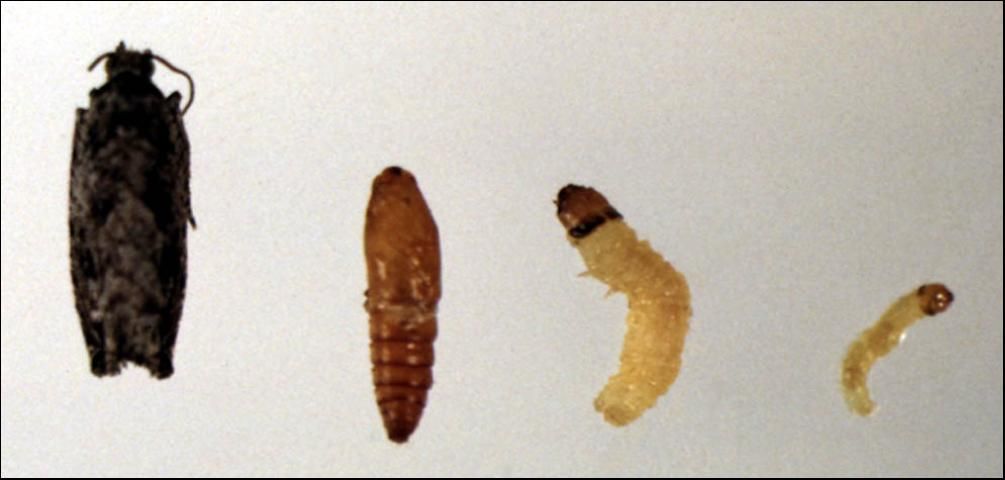

Pecan bud moths can complete a generation in about one month, depending on temperature and available host material. About six days are spent in the egg, fourteen days as a larvae, and eight days as a pupa under ideal conditions. There are probably 5 to 6 generations per year.
Infestation
Bud moths may defoliate mature pecan trees (Figure 3), feed on young nuts in spring, and infest shucks in the fall. However, their major damage is to nursery stock and newly transplanted trees. Figure 3 shows a terminal bud infested by a pecan bud moth. When the terminal buds are occupied or have been destroyed, bud moth larvae become leaf rollers (Figure 4).
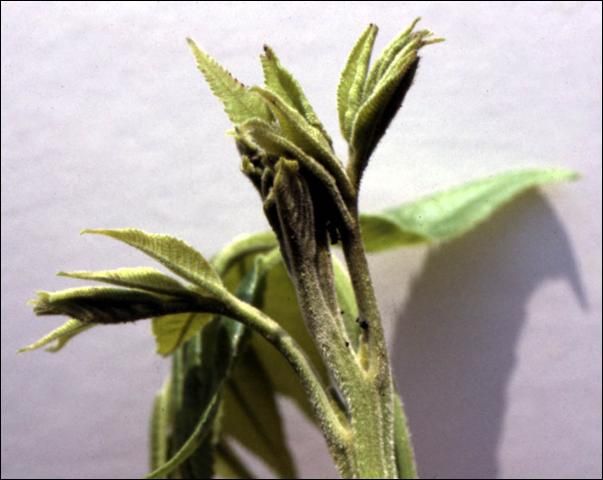
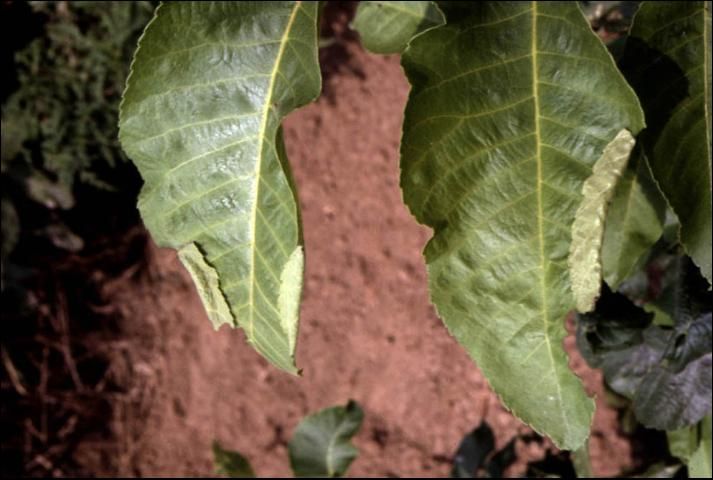
Feeding by bud moth larvae in buds and shoot apices destroys the buds, causing multiple branching (crow's feet) of the terminals and growth of unwanted lateral branches (Figure 5). Excessive branching decreases tree height, necessitates costly pruning in nursery stock, and also results in poor structure of transplanted trees (Figure 6). Damage to transplanted trees in the orchard often leads to delayed growth, poor shape, and the death of infested trees (Figure 7).
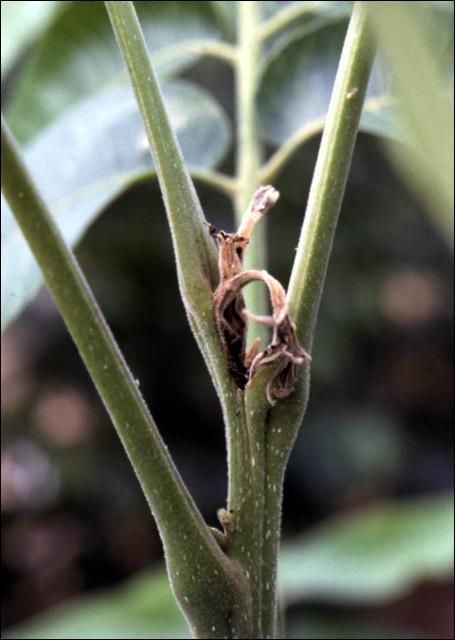
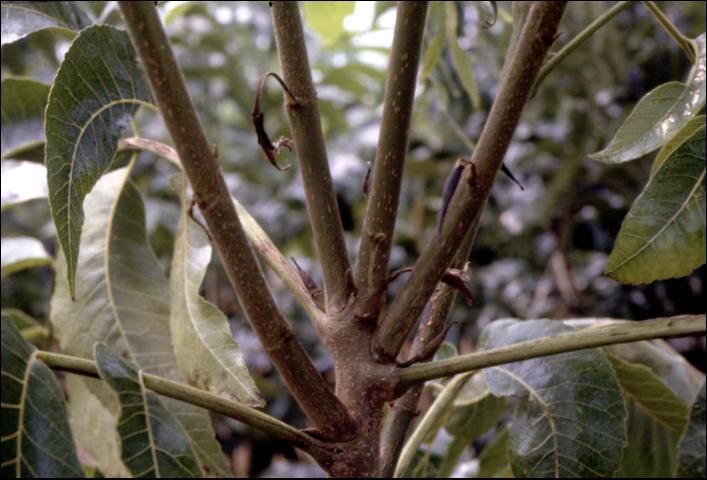

Control
Transplanted Trees
Newly transplanted trees should be treated to control the bud moth. A recommended insecticide should be applied at or before budbreak, and repeated at 2 to 3 week intervals until the foliage is well established. Control of the pecan bud moth on mature trees is usually accomplished through sprays applied for other pecan pests.
Nursery Stock
Grafted nursery stock should be sprayed with a recommended insecticide on a 2 to 3 week schedule to control the bud moth from budbreak until the trees attain a height of five feet. (See Insect Management in Pecans [ENY-806] for the appropriate registered chemicals.)
In seedling nursery stock (ungrafted), bud moth control is not recommended because diameter growth rather than height is the goal. Thus, bud moth control is not cost effective.
Pesticide Precautions
Read the entire label, including the small print, before opening the container. Be sure the pest and plant involved are listed on the pesticide container label.
All insecticides are poisons, and the safety precautions on the container labels must be followed.
Keep pesticides from getting into fish ponds, streams, and water supplies.
Avoid drift of pesticides to adjacent areas or to crops that may be eaten by man or animals.
Store pesticides in their original labeled containers, out of reach of children, pets, and preferably under lock and key.
Dispose of leftover spray materials and empty containers promptly and safely.
Selected References
Mizell, R. F. III and D. E. Schiffhauer. 1986. Larval infestation levels of pecan bud moth, Gretchena bolliana Slingerland, in relation to cultivar and position on the tree. Environ. Entomol. 15:436-8.
Mizell, R. F. III, F. Martin and P. C. Andersen. 1987. Pecan nursery stock: Models of height and diameter growth and impact of pecan bud moth Gretchena bolliana (Lepidoptera: Tortricidae). Environ. Entomol. 17: 13-17.
Ree, B. and A. Knutson. 1997. Field guide to the insects and mites associated with pecan. TX A&M Univ. System Publ. B-6055. 127 pp.